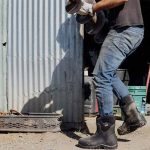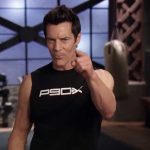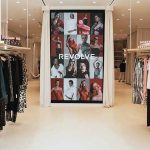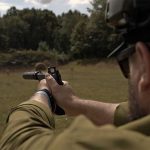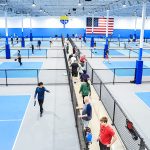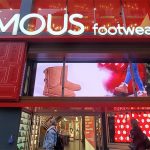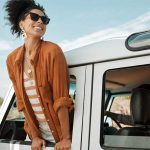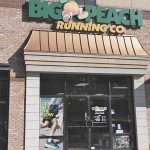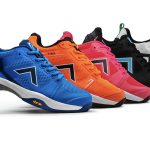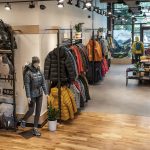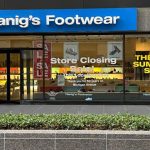On the flight to Las Vegas for the MAGIC show last Tuesday I thought about complaining about making the fourth trip to the city-that-never-sleeps in as many weeks for trade shows. Then I thought about the exhibitors and attendees stuck under two feet of snow in New York City at the Javits Center for the Toy Show.
I dont think Ill kvetch about Vegas again for awhile
While the weather was not an issue IN Las Vegas, it most certainly had an impact on people attempting to get TO Las Vegas. Estimates ranged from 10% to 20% of attendees canceling due to the wicked weather in the East last weekend. Timberland said that ten of the fifty corporate employees that expected to make the trip were stranded in New Hampshire. If you didnt get out early Sunday, you didnt get out.
Like the many shows preceding it this year, Magic was impacted by lackluster attendance and fairly empty aisles-unless you were in the South Hall.
The show really was a story about competing formats in one convention center. When the show organizers decided to split off Young Mens, Kids and Streetwear to the South Hall of the Las Vegas Convention Center, it was expected to be part of a broader plan to segment the show by buyer focus.
The result was the draining of the energy from the balance of the show. The exhibitors that once complained about the noise generated by the “street crowd”, were now complaining that the excitement was gone from their aisles in the Casual and Active Lifestyle sections.
We are intrigued by the many nascent brands in the Streetwear section that have been able to create a great deal of energy around athletically-inspired apparel while established athletic brands cant seem to get out of the blocks with the target urban consumer.
Licensed — and licensed-inspired — apparel was again the driving force behind much of the energy, signaling loud and clear that this consumer is clearly still connecting with product influenced by sport. Why cant the larger athletic brands connect in the same way?
Reebok was in the South Hall with its Onfield Licensed Apparel division, but the company did not show any branded apparel. Nike wasnt in attendance and adidas only worked the Kids hall. Russell had a meeting room near the Casual hall. Fila and Puma both had apparel booths laced with footwear and K-Swiss hung out a footwear shingle as well.
But what was evident is that the “street” or “urban” brands have taken the look and feel that originated with many of these athletic brands and have tweaked elements to connect with the target consumer. Price is not an issue. While the athletic brands are mired in lower price conversations with sporting goods retailers and department stores, these smaller brands are selling jerseys, warm-ups and jackets for $300 and up.
Converse seems to be bucking the trend by licensing the brand to urban fashion apparel maker, akademiks. The effort is spearheaded by former Starter sales guru and now akademiks COO, Dan Raskin.
Using traditionally athletic colors and silhouettes that coordinate well with Converse mainstays like the Weapon, akademiks has raised the level of style and design through detail, interesting materials and “bells & whistles”. The result is a product line that retails at the higher end and supports and upgrades the Converse brand message. The challenge will be distribution, with akademiks positioning Converse apparel in the urban menswear shops and Converse focusing the footwear effort at Foot Locker, Modells, etc… Foot Locker still has a license to make basic Converse apparel.
Reebok is starting to push the pricing envelope with licensed apparel, positioning some new NBA warm-ups in the $350 range. Onfield COO David Baxter also indicated that the company will take the next step in its licensed efforts with an expanded jacket offering for fall.
But the award for hype and energy had to go to the Ounk apparel booth that played to standing room only crowds every day of the show. While newer brands have been accused in the past of filling their booths with bodies to create an illusion of busy, Allan Houstons Ounk used their open booth format on a main aisle to showcase buyers dropping paper for multiple deliveries. The result was a feeding frenzy for the street-inspired licensee of NBA denim and active apparel created by the Knicks player and his partners.
The invitation-only “Pool Show”, held simultaneously with MAGIC down the street at the Alexis Park, provided a fresh approach to a trade show. Modeled on the successful Bread and Butter show in Germany and the new To Be Confirmed show in NYC, young funky lines were presented in a layout quite different than what we are used to in the athletic footwear industry.
Instead of stadium-sized booths with armed guards and competing sound systems, each line at the Pool Show was given a table, a rolling rack and a chair. Show management presented uniform signs for each “booth”. One DJ provided background for the entire venue. The net effect was an emphasis on the product creating the excitement – instead of the booth and the hype. And great and creative product it was!
Somehow, brands that are usually part of the bigger shows snuck in and were making an impression. Asics sensational Onitsuka Tiger brand was there, as was adidas alternative division and a small collection from Fila. Dr. Marten veteran Bill Cohen was in attendance with Brit sport fashion collections Quick and Walsh. Quasi-active brands like Penguin and Medium had booths.
Fashion retailers like Patricia Fields, Up Against the Wall and Sportie LA were all in attendance, but no BOGOers were allowed in.

